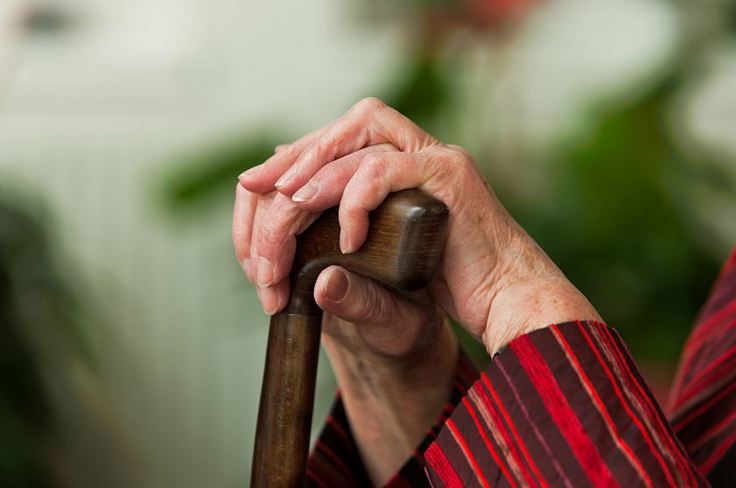Osteoporosis and fractures in Norway - fact sheet
Article
|Last update
|Each year, approximately 9,000 adult Norwegians fracture their hips and 15,000 fracture their wrists. A large number also suffer from vertebral compression fractures in the back. Women and men in Norway have among the world’s highest fracture incidence. Osteoporosis is a major contributing factor for fractures in older people.
Osteoporosis
A gradual reduction in bone mineral density is part of the aging process.

Osteoporosis means that the bone mineral density has decreased to a level below a defined threshold. This can be due to accelerated bone loss, or a lower than usual bone mineral density before the bone loss starts. Osteoporosis may also occur as a consequence of certain diseases or use of certain drugs.

Osteoporosis involves loss of bone mass and an impairment of the bone structure, making the bone tissue more porous and susceptible to fracture. It is a risk condition and causes no symptoms before a fracture occurs.
The hip, forearm and spine (vertebrae) are the most common fracture sites.
The images show normal bone (top) and osteoporotic bone (bottom). Osteoporotic bone is characterized by a thinner structure with larger cavities.
Prevalence of osteoporosis
Based on measurements of bone mineral density in representative samples of the population, an estimated 300,000 Norwegians have osteoporosis. The prevalence of osteoporosis may vary depending on the measurement site. It is higher in women than in men and it increases sharply with advancing age.
9,000 hip fractures a year
Hip fractures are the most serious fracture related to osteoporosis, both in terms of the consequences for the individual patient and the high number of hip fractures. Most of these fractures are a result of reduced bone mineral density combined with a fall.
In Norway, approximately 9,000 adults experience a hip fracture every year, which means that a new hip fracture occurs every hour. Two out of three hip fractures happen in women. The risk increases sharply from age 70 years, see Figure 1.

Hip fractures typically occur in the neck of the femur or just below it.
National figures show that the age-adjusted incidence of hip fractures has declined steadily since the turn of the millennium (see Figure 2), with a reduction of 27 percent in women and 20 percent in men from 1999 to 2019 (Kjeldgaard, 2022). A similar trend is observed in other countries.
A Norwegian study suggests that two-thirds of this decline can be attributed to changes over time in population risk factors, such as increasing body weight (fewer individuals being underweight), a decrease in the prevalence of cigarette smoking, and a significant rise in the number of people living with hip prostheses due to osteoarthritis. Increased use of osteoporosis medications accounted for only one-fifth of the decline, as relatively few use osteoporosis medication (Kjeldgaard, 2023).

Although fracture risk has decreased over time, the annual number of hip fractures remains stable at around 9,000 due to the increasing number of older individuals (above age 70) in the population. The number of hip fractures has increased among men and decreased among women (Kjeldgaard, 2022). However, future numbers of hip fractures are projected to increase for both men and women by 2050 due to the growing number of older people in the population, even if individual risk declines (see Figure 3). This highlights the importance of intensifying preventive measures to manage the increasing burden on the healthcare services (Kjeldgaard, 2025).

Fractures of the wrist and spine
Wrist fractures are often a result of osteoporosis combined with falls. Each year, an estimated 15,000 adult Norwegians fracture their wrists (Andreasen, 2024). Wrist fractures are also referred to as forearm fractures.
It is estimated that approximately 140,000 women and 90,000 men aged 50 years and older have fractures in the spine (where the vertebra is compressed). Such fractures are most often a consequence of osteoporosis. An unknown number of individuals experience chronic pain following these fractures.
Risk factors
Gender, age, falls: Women have close to double the risk of hip fractures compared to men. Fracture risk increases with age and with the degree of osteoporosis. In addition, the risk of falling increases with age. These factors contribute to an 80-year-old woman having approximately 25 times the risk of hip fracture compared to a 55-year-old woman (see Figure 1).
Approximately 30 percent of people aged 65 years and older fall each year (Montero-Odasso 2022). Falls are even more common in those above 75. In a study from Norway, 307 home-dwelling women in Oslo aged 75 years and older (average age 81 years) were followed for one year. More than 50 percent reported having fallen once or more during the year, and 13 percent of the falls resulted in fractures (Bergland, 2004).
Previous fractures: Individuals who have already experienced an osteoporotic fracture have a significantly increased risk of subsequent fractures (Ahmed, 2013; Omsland, 2013).
Ethnic background: Internationally, white European and North American women have the highest risk of fractures, while Asian and African American women have the lowest risk. In data from Norway, the risk of fractures in the hip and wrist is significantly lower among individuals of Asian descent compared to those born in Norway (Aamodt, 2020; Oftebro, 2024).
Smoking, physical activity, weight and diet: Smoking, low physical activity, and low body weight are important risk factors for fractures. A varied diet providing sufficient energy and protein can help prevent weight loss which involves loss of bone and muscle tissue. Sufficient calcium and vitamin D are also necessary for preventing bone loss.
Other factors are also of importance (see Table 1).
Non-modifiable risk factors | Modifiable risk factors |
|
|
Bone densitometry
The purpose of measuring bone mineral density is to identify the individuals who may benefit from osteoporosis medications or other fracture prevention measures. The Norwegian Directorate of Health recommends that patients at risk of secondary osteoporosis (e.g., after long-term corticosteroid treatment) should be offered bone densitometry. It is also recommended for women who have experienced a low-energy fracture after menopause or who have several risk factors, such as early menopause, low body weight, significant weight loss, a family history of fractures, smoking, other medical conditions or use of medications that may affect fracture risk, or a tendency to fall (Norwegian Directorate of Health, 2014).
National guidelines for the prevention and treatment of osteoporosis and osteoporotic fractures were last published by the Norwegian Directorate of Health in 2005 and are now outdated. As of 2025, work is underway to develop new and updated guidelines.
Preventive treatment of osteoporosis and fractures
Various medications affecting bone, combined with calcium and vitamin D supplements, are available to reduce fracture risk in individuals diagnosed with osteoporosis. These medications include bisphosphonates, denosumab, selective estrogen receptor modulators (SERMs), parathyroid hormone, and romosozumab. Estrogen therapy increases bone mineral density and reduces fracture risk; however, it is not first-line treatment for preventing fractures because long-term use seems to increase the risk of other diseases. Information on the treatment of osteoporosis is available at Helsenorge.no.
A study in Norway showed that after a forearm fracture, only 11 percent of women and fewer than 3 percent of men used fracture preventive medications. Five percent of the women and 1 percent of the men initiated such medication in the year following the fracture (Hoff, 2015). This low proportion is unfortunate given that the patients are at high risk for subsequent fractures and that medication may help reduce this risk considerably.
Hip protectors can help prevent hip fractures in older people living in nursing homes (Bentzen, 2008).
Since lifestyle factors influence fracture risk, changes in modifiable risk factors are also recommended (see Table 1).
Fracture treatment and rehabilitation
Wrist fractures are most often treated without surgery. Spinal fractures are managed with pain relief, bed rest for the first few days, and physical therapy. For individuals with severe pain, hospitalization may be required. Patients who sustain hip fractures are almost always admitted to the hospital for surgery. While many recover after a hip fracture, there are also many who experience impaired function after the fracture and become dependent on an increased level of care. Among home-dwelling individuals aged 70 years and older in Trondheim who suffered a hip fracture, only 13 percent were able to return directly to their own home after surgery. Approximately 17 percent were deceased one year after the hip fracture, and among those who survived, one-fifth were admitted to permanent care in a nursing home during the year following the fracture (Hektoen, 2016).
According to a study conducted in Oslo in 1996-97, six percent of hip fracture patients below 75 years and 33 percent of patients above 85 years needed to move to a nursing home after the fracture. Half of those who could walk independently before the fracture lost this ability (Osnes, 2004).
There is high excess mortality during the first year after a hip fracture, partly due to already impaired health prior to the fracture. Survival during the first 30 days after a hospital admission with a hip fracture varies between hospitals and is used as a quality indicator for treatment (Norwegian Institute of Public Health, 2023).
The average costs associated with hip fractures in home-dwelling individuals aged 70 years and older were estimated in 2014 to be just above 500,000 NOK during the first year following the fracture (Hektoen, 2014). For those who survive the first two years, the total cost resulting from the hip fracture increases to 800,000 - 1,000,000 NOK. In total, these costs amount to approximately 9 billion NOK per year.
Why does Norway rank among the highest in the world?
Norway, along with the other Scandinavian countries, ranks among the highest in the world in terms of incidence rates of hip fractures. This is not explained by slippery roads in the wintertime; hip fracture rates in Norway are high also during summer. In contrast, wrist fractures occur more frequently outdoors, with greater variation related to season, weather and surface conditions (Dahl, 2022).
The reasons behind the high fracture rates in Norway and Scandinavia are largely unknown. Possible factors include lower body weight and greater body height compared to populations in Central and Southern Europe, but these differences alone are not sufficient to explain the high fracture risk in Norway (Lofthus 2001, Meyer 1995).


